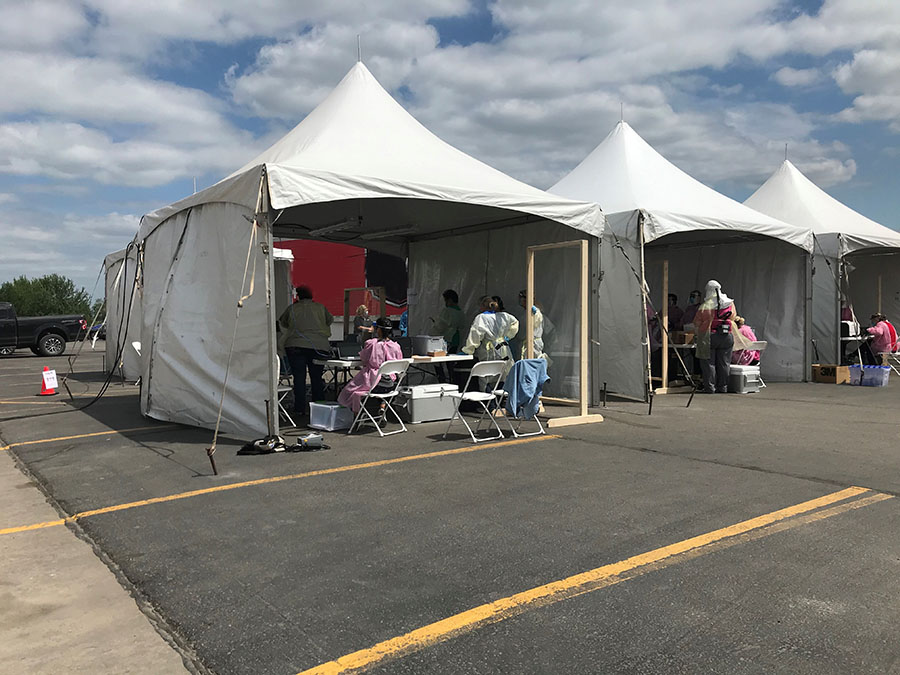Aquatics FAQs
Recommendations for Fully Vaccinated People
COVID-19 Homepage
Getting the Word Out to Protect Meat and Poultry Plant Workers

CDC attended a mass testing event and toured a meat processing facility in South Dakota in June.
In the face of an infectious disease outbreak without a vaccine or known treatment, communicating prevention messages is critical to slowing the spread of the pandemic.
Recommended protective measures like social distancing, cloth face coverings, and frequent handwashing are the same for everyone. But some people face more barriers when it comes to taking these actions, and some are harder to reach with messaging.
In late April, as New York and other major cities faced devastating surges of COVID-19 cases, millions stayed in their homes and left only for necessary items like medicine and food. But the pandemic also reached beyond the cities, to the small rural towns where much of that food gets packaged. Meat and poultry plant workers continued to go into work, where social distancing was a challenge. Outbreaks in meat and poultry plants could affect entire towns. And some of these towns are in areas where healthcare services and testing are hard to access.
Maggie Silver, a health communication specialist at CDC’s office in Fort Collins, Colorado, recalls seeing an uptick in cases among workers at a leading beef processing plant in nearby Weld County. The plant closed for 10 days to put a hold on the spread of COVID-19 in the facility and to come up with a strategy to reopen and stay open, as the federal government announced that the food production industry was an essential service.
Maggie’s co-worker in Fort Collins, Dr. Marc Fischer, was dispatched to work with the plant’s management, the county health department, and the workers’ union to develop a mitigation strategy. The team quickly recognized that containing the outbreak would depend on effective communication with employees, the community, and partners. That’s when Marc called on Maggie to develop a risk communication plan.
Recognizing the value of communication
“I really appreciated the team’s understanding of the importance of communication in this situation,” Maggie says. “For many of the plant workers, English is a second language, and the health and financial risks involved complicate the situation further.”
Getting workers safely back to the plant and maintaining the food supply required communicating messages that would promote behavior changes among workers and supervisors. In two days, Maggie developed a risk communication plan for the plant and got buy-in from the company and county health department. It included main prevention messages and outreach strategies such as texting workers, posting signs around the facility, and sharing messages through trusted sources like the union and community organizations.
A few weeks later, a CDC team deployed to Pierre, South Dakota, asked Maggie to support their efforts. In a state that has more cows than people, meat and poultry production is a big part of South Dakota communities, and COVID-19 spread in facilities was an ongoing concern.
This time, Maggie had a more hands-on approach on the ground while the facilities remained open. She was able to visit a facility with rising numbers of COVID-19 cases when the plant manager invited a multidisciplinary team of the state health and agricultural departments and CDC staffers to tour the facility and provide recommendations.
“Employees in these facilities are in constant motion when working,” Maggie says. “They are quickly changing for their shift or doing their job on the floor. Lunch is their only down time.”
Posting messages where workers pause
Maggie recommended placing signs with prevention messages in areas where the employees might pause, like around the lunchroom, time clocks, and bathrooms, and suggested sending reading materials home with workers. She learned that, as in Colorado, the employees and members of the surrounding community come from many different ethnic backgrounds and many speak and read limited English. Picture-based signs with little text would help broaden effective outreach.
“One thing that struck me when working with the production company was how much management cared for their employees,” Maggie says. “When touring the facility, they stopped and greeted many of the employees by name and asked about their families. They were very concerned about the health of workers and the community.”
The risk communication plan that Maggie developed for these two companies has been adapted and used in other meat and poultry production facilities. Strong partnerships and tailored risk communication messaging continue to be essential tools in protecting workers and communities.
Getting the word out meant first truly understanding the community interactions and daily lives of the workers. Trusted community groups, like refugee organizations, helped get messaging to the workers and their families.
“The first step to coming up with any plan to support these facilities is to get to know all of the partners involved and their roles and goals,” says Maggie. “Workers’ unions, community groups, health departments, and facility managers all play an important part in keeping the facilities open.”